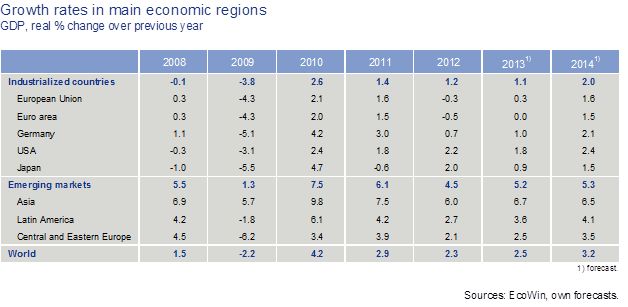 |
|
At the end of 2012, the global economic picture was still very mixed. Although global industrial production and international merchandise trade picked up again somewhat – having practically stagnated in the spring and summer – the improvement was largely the result of greater momentum in the Asian emerging markets. However, of late, there has been evidence of an expansion in production on a broader front. Following a continuous decline since the second quarter of 2012, overall industrial production in the advanced economies is likely to rise again in the first quarter of this year. And world trade is also displaying clear signs of picking up, with provisional figures flagging a strong 1.9% rise in January.
Nonetheless, 2013 is not likely to be an easy year either. Although considerable progress has been made in correcting erstwhile adverse trends, in many cases the adjustment process is not yet over. Above all, the ongoing consolidation of public sector finances in the industrial countries, but also the need for structural adjustments in a number of emerging markets, will thwart buoyant economic momentum.
The ability of a host of economies, particularly among the industrial countries, to cope with shocks looks very limited. The Eurozone debt crisis still harbours risks for global growth. Although there is much to suggest that the let-up in the European debt crisis is set to last, undeniable risks still lurk – for instance, waning zest for reform. Finally, rising geopolitical tensions, such as the row over the Iranian nuclear program, could exert a considerable drag on the global economy, not least if these send crude oil prices skywards.
Growth in the Asian emerging markets is set to come in at 6.7% in 2013, somewhat higher than last year (+6%). This will be driven by an expected acceleration in China and buoyed by recent progress on the reform front in India, which has lifted industrial sentiment appreciably. For 2014, we are penciling in Asian emerging market GDP growth of 6.5%.
Over the last 35 years, China has experienced very strong growth, averaging +9.9% a year. In recent years, however, growth has slowed somewhat. In 2012, real GDP grew by 7.8%, the lowest increase since 1999. This slowdown in growth evident since mid-2010 was at least partially the result of a conscious attempt by policymakers to curb business activity, with the aim of countering overheating symptoms in various sectors of the economy, such as real estate. In future, China’s growth rates will be considerably lower than they used to be.
An overhaul of the Chinese growth model is essential, first and foremost given the rapidly rising gap between rich and poor. The transition will take many years, most likely more than a decade. Setbacks are inevitable. In order to re-jig its growth model, China is turning many screws at the same time. In this context, unwanted repercussions on economic growth cannot be ruled out. However, the Chinese government has enough fiscal firepower at hand to stem such a development.
On the back of infrastructure investment, solid private consumption and the modest recovery in world trade, we expect the Chinese economy to gain some momentum this year. Real GDP is likely to grow by 8.3% in 2013. In the medium term we foresee average annual real GDP growth of 7%, well down on previous levels.
Given official plans to boost and spread wealth more evenly, with the number of middle-class households set to rise to 40% of total urban population by end-2015 (from 25% now), the number of potential customers is set to rise sharply, particularly in inland areas. In addition, with the nationwide fertility rate declining further and life expectancy expected to rise to 75 years, the pension system will need a major overhaul. In this environment, commercial health insurance and pension provision is destined to play an increasingly important role. All in all, we expect the Chinese insurance market to grow by 12.1% a year in the next decade, overtaking Japan as the biggest market in Asia and becoming the second largest insurance market worldwide.
Michael Heise is the group economist at Allianz










